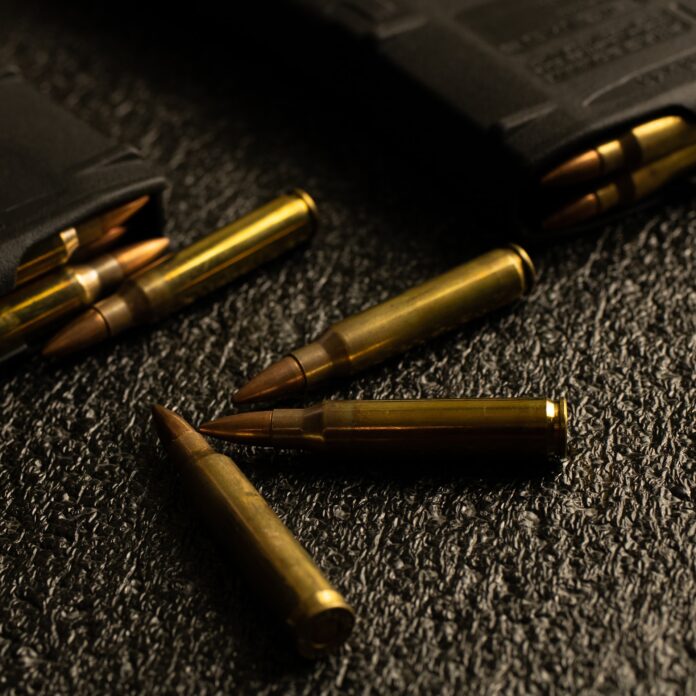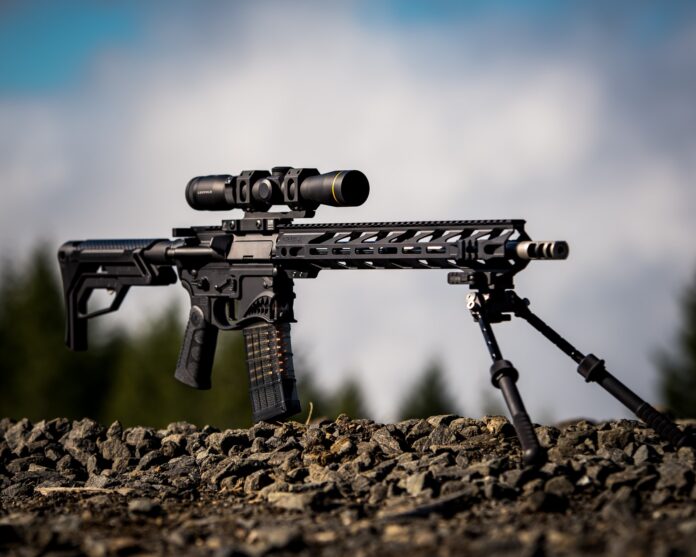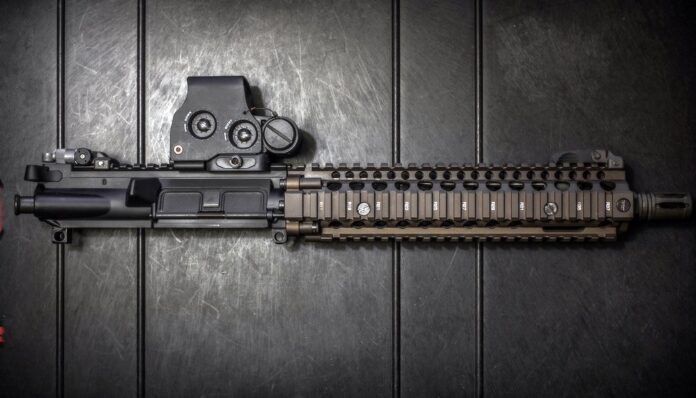Precision rifles have been manually operated bolt-actions for decades. But with newer manufacturing and a greater understanding of gas-operated systems, semi-automatic rifles are beginning to take over the precision rifle sphere.
But how do you assemble a precision upper for your AR-15? We’re going to go over some of the factors you need to consider when selecting parts for your precision build. But first we need to know a few things. If you are looking to get the ball rolling with a stripped upper receiver, find it here. The upper contains the barrel, free float handguard, and muzzle device making it one of the most important parts of an AR-15 if you are looking to add some precision to your rifle. It also allows the attachment of a scope, which is a necessity for long range shooting.
What is Precision?

Precision and accuracy are terms that pop-up a lot in these discussions. Almost all of them come with buzz words such as “Sniper”, “Marksman”, or even things like “Special Purpose Rifle”.
Practically, these terms apply to how small a target we can hit repeatedly at various distances. The precision of the early 1900s is not the same as the precision of today. In fact it’s roughly one-half to one-fifth the acceptable size.
A rifle was considered accurate if it had a 5 Minute-Of-Angle (MOA) group at 300 meters. This translates to roughly the size of the upper chest. This acceptable target size expanded to the entire torso the farther out you went.
Today we expect our non-precision rifles to provide 2 MOA or less on the civilian market, with precision rifles getting better than that.
Obviously distance plays a large factor when we are trying to get a precision build going. A gun that is accurate at 100 meters or yards will have a much wider group the farther your target is. So we are going to assume that your targets will be between 500 yards and 800 yards.
This estimate gives us a wider variety of options than extremely long ranges would allow us. Let’s look at our factors.
The Barrel
High-end precision guns take a lot of fine tuning but since we’re assembling our own precision upper we need to keep it simple.
The barrel is one of the major factors when it comes to precision shooting. If you are serious with the build you should have a free floated barrel that is match grade.
Match grade barrels are designed to get as much accuracy out of them as possible. Their profile is up to individual preference. However some profiles are better for keeping the barrel cool or help cool the barrel faster so your accuracy is not impacted by heat as much.
Another important factor is if the barrel is free-floated or not. You should have your barrel free floated for a precision build. This allows you to fire the rifle supported without applying pressure to the barrel which will affect your group size and placement.
Barrel length is also a factory but it ties in with the caliber of the gun and the twist rate, which we will cover next.
Caliber and Twist Rate

Ammunition quality, the caliber, and the twist rate of the barrel tie into our overall accuracy goals. Match grade ammunition or similar precision minded loadings will help you eek out as much accuracy as possible.
While many people don’t think of 5.56×45 NATO as a long distance round, it has a longer effective range than many people give it credit for. While 1000 yard hits are possible, even with a good grouping, this is not as repeatable outside of ideal conditions.
Depending on your powder, projectile, and other factors 5.56 can easily cover out to 500 yards. Beyond that we start to see diminishing returns on our effort. But for target shooting it can very easily reach 800 yards. For terminal use, such as coyote hunting, it would be a better idea to split the difference and try to keep our shots within 650 yards.
All of these will benefit from the length of the barrel and its twist rate. The barrel can be anywhere from 16” to 20” with some being even shorter depending on the round you choose. However what matters the most in this equation is the twist rate.
The tighter the twist rate the better the bullet will perform out of shorter barrels. This stabilizes the round better, allowing for less deviation at distance. Longer barrels can get away with slower twist rates since the projectile spends more time in contact with the rifling for longer.
Generally a good twist rate for shorter barrels is 1:10 and it can be used as a type of standard for your twist rates.
Receiver and Rail
The final considerations are for the receiver and rails. A quality upper receiver will help make sure the entire gun locks together well and provides a sturdy platform for the barrel to work off of.
The receiver should be a flat-top style, which allows for you to mount a scope for your precision shots. The rail should not be an add-on, but rather built into the receiver in order to provide a stable base for it.
This rail can extend to the hand guard, which may be required if your scope mounts are particularly long or you need more eye relief.
If you do need to have the mounts placed over the receiver and the handguard, consider a monolithic receiver. Monolithic receivers have the handguard and upper receiver be one solid piece of aluminum. This is a benefit because the shifting of a scope mount will cause wandering zeros, impact shifts, and other problems for repeatable accuracy.
Your scope should be mounted to a secure part of the rifle that is unlikely to shift around under stress. Other benefits from having rails and handguards on your precision rifle is the mounting of bipods or similar tools for shooting supported.
Other Considerations

One thing we have not talked about is the gas system of the AR-15. The gas system is over looked a lot of the time but it is the heart of the firearm’s function. You should try to make sure your gas-system is tuned to your particular ammunition for best results.
However the finer you tune it, for example to a specific brand or load of ammunition, the less effectively it will use other loads. Be sure you know what types of ammunition and their loadings you are most likely to use in your precision gun before you tune it.
Conclusion
This is just the surface of building a precision AR-15, much of what is required to achieve the greatest success goes into engineering and gunsmithing. That would require much more detail beyond our current scope.
However this should give you the right idea of what to look for when you’re starting your precision AR-15 upper.







